
Mining Memorabilia - Paranumismatics (Part II)
Probably the most commonly collected type of mining paranumismatics are known by several names depending on which coalfield or even region of a coalfield they emanated. Common names for suck items include "Checks", "Tokens", "Tallies", "Motties", "Pins", "Tickets" or "Passes". In the following brief description they will be referred to by one of their more common titles, i.e. "Pit or Colliery Checks". Although the vast number of such checks emanate from the coal mining industry they were also used in some metalliferous ore mines and some stone quarries. They were used for a wide variety of identification and tallying purposes.

Obverse of a brass cage riding (or possibly lamp) check from Halkyn District United Mines Ltd.'s (H.D.U.M. LTD) lead mine on Halkyn Mountain, North Wales. Dates from the period 1928-69. Actual Size 39mm.
The use of Pit Checks is believed to have commenced in Britain c.1860/70 and continued into the 1980/90s when they were eventually replaced by the introduction of electronic swipe cards.
Pit checks are one of the most commonly encountered forms of mining memorabilia. The total number of different examples ranges well into the thousands. Although most of them are less than 100 years old their are still several types for which the original purpose or method of use remains unknown. This makes their study all the more interesting.
Pit checks were produced in a variety of different materials and designs. However, in common most normally bear hand stamped identification numbers in the centre of their obverse fields. They were typically manufactured in either brass, zinc or aluminium although plastic/bakelite and leather examples are also known. The majority of pit checks have embossed or incised uniface designs and are encountered in several different shapes including circular, square, rectangular, hexagonal or octagonal.
Possibly the earliest true colliery checks (lamp or possibly even time checks) know of are those used at Elsecar Low Colliery in South Yorkshire. Few of these examples remain in existence. These earliest known checks are of a brass embossed design and are unusual (although not unique) in that they bear a date in their legend. Their obverse design carries the legend ELSECAR LOW PIT while the reverse legend simply reads EFW 1882. The latter initials refer to the colliery's then owner Earl Fitzwilliam. Other than being a possible date of issue NMMA researchers have so far failed to find any other significance to the date on these checks.
Instead of bearing the usual hand stamped collier identification numbers the early Elsecar Low Pit checks each carry two hand stamped initials. These have since been shown (via reference to an original 1881 manpower ledger for the pit) to represent the initials of the miners' to whom the checks were originally issued. In this respect the checks are apparently unique.
It is probable that the use of lamp/time checks pre dates 1882 by at least a decade or two. Certainly by the early 1900s they were in common use in most coalfields. This is attested to even in Co. Durham where it is clear from the coroner's summing up comments regarding the 1909 Burns Pit (West Stanley) disaster, that numerous collieries in that district were already in the practice of using lamp tokens. Such tokens not only acted to indicate which lamp was commonly used by which miner but more importantly acted as a means of recording the number of men working under ground on any particular shift. This was essential information not only to colliery management, who used the tokens as a form of work attendance tally, but more importantly as an indicator to rescue teams of the potential number of miners involved in the event of an explosion or other type of pit disaster.

Obverses of two pre 1947 brass lamp tokens from Co. Durham. The first from Auckland Park Colliery, the second from Seaham Colliery. Actual Sizes are 42mm and 39mm respectively. "B.V." are the initials of Bolckow Vaughan & Company (later to become part of Dorman Long) the Teesside base Iron makers who owned several collieries in Co. Durham plus Ironstone mines in Cleveland.
By 1913 the use of checking systems in British mines had been made mandatory by a supplementary amendment to the Coal Mines Act of 1911.
Most of the early checking systems employed only one token (usually of brass) per collier. This token was often referred to as a lamp check/token and was often taken home with each collier at the end of each working day. Such lamp tokens were handed in to the lamp room attendant at the start of each shift in exchange for a safety lamp bearing the same identification number as that on the collier's personal check. At the end of his shift the collier would retrieve his check from a tally board in the lamp room or alternatively directly from the lamp room attendant in exchange for the safe return of his lamp.
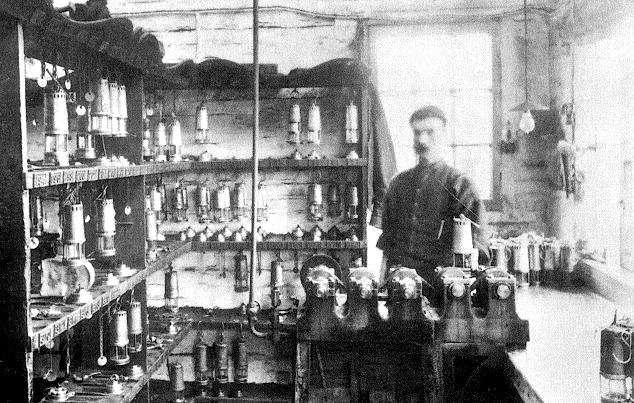
Gibfield Colliery (Lancashire) lamp room 1905. Note the brass lamp checks hanging from chains and string in the place of the certain numbered safety lamps that have been withdrawn from the lamp cabin for service by colliers on shift.
The precise method of use of the colliery check system varied quite considerably between coalfields and with the passing of time. Some areas operated a two check system others a three check system. Many mines also used additional pay checks/tokens for identification purposes for workers collecting wages. In some areas the checks were used only for lamp issuing in others they were used in conjunction with surface and underground manpower deployment boards.
|
|
|
Banksman's token collection box from an unknown Colliery in central County Durham plus a brass "check torpedo" used to transfer checks via a pneumatic conveying system between the banksman, lamp room and time office. This particular example was used at Wolstanton Colliery in North Staffordshire.
In most systems each collier usually collected two personally numbered checks of different shapes or metals from the time office on arriving at work. Subsequently each miner handed in one check to the banksman on entering the cage before descending the pit. The banksman then returned each shift's checks to a board in the lamp room or time office. Each collier retained the second check on his person until returning to bank at the end of his shift where he handed it back in to the lamp room or time office, often via the banksman.
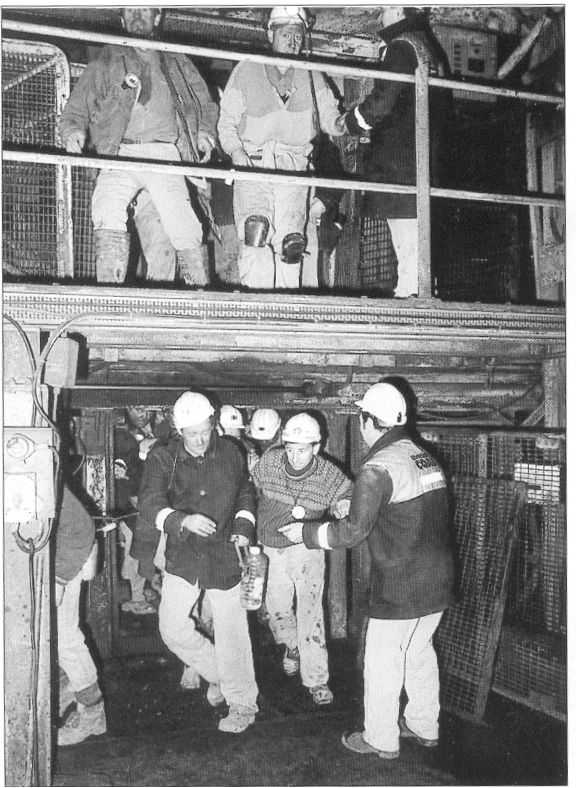
Colliers leaving the double decked cage and handing in their pit checks to the banksmen at Vane Tempest Colliery (Co. Durham) c.1993. (Photograph courtesy of Ron Hindhaugh collection).
In all over 22 different uses for checks have been recorded in the British coal industry since c.1900, and several more obscure ones before this date.
Amongst the various post 1900 check examples are include the following types;
Lamp issuing checks/tokens
Cage riding and manpower deployment checks
Pay Checks/tickets

A set of three emergency organisation or rescue checks (each 32 mm diameter) from Fryston Colliery in Yorkshire. The checks are complete with their original envelope and instructions for issue/use.
Explosives Container identification tallies
Shot firing sentry identification checks
Tub tokens/checks (often called putters and hewers tokens in the North East)
Morphia Key tallies/fobs
Railway and bus free travel passes/tokens
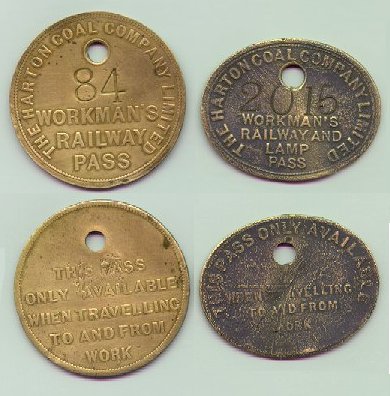
Obverse & reverse of a Harton Coal Company Railway Pass plus a combined Railway & Lamp Pass. These passes were used on the Harton Coal Company's private railway line between South Shields and Whitburn Colliery. These date roughly to the period 1900 to 1947. Actual sizes 50mm & 53mm by 31mm respectively.
Canteen checks/tokens
Pithead baths tokens and identification checks
Cycle shed tokens - for the identification of individual bicycles
Wood Removal passes/tickets - These were used in certain Welsh pits prior to 1947 as a gate pass to prove that wood off cuts were not being removed from the colliery premises illegally
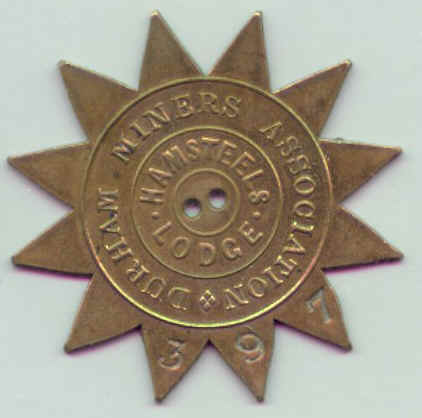
Obverse of a brass Durham Miners' Association check (c.1910-30) from Hamsteels Colliery Lodge. These early union membership badges were sewn onto the miners' jacket lapels or caps to indicate to others that they were paid up union lodge members. Actual Size 51mm.
Miners Association membership checks/badges
Emergency rescue team deployment tallies
Work tool identification/issuing tokens
School payment fee tokens (North Derbyshire Coalfield only)
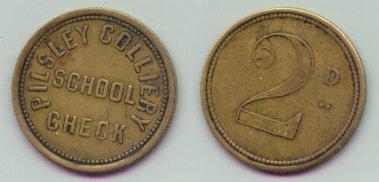
A brass 2 penny colliery school token issued to Pilsley colliers c.1880-1900. These tokens would be presented by the collier's children each week at school. The local school board would then submit the collected tokens back to the coal company who would exchange them for payment in legal tender. Actual Size 28mm.
Commemorative and/or promotional checks/fobs
Stall checks
Concessionary coal delivery checks
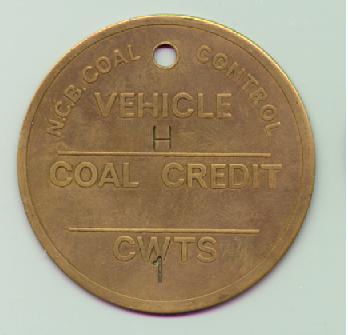
Obverse of a brass 1 cwt concessionary coal delivery check. These checks were issued to those colliers who were entitled to a weekly concessionary house coal allowance. On arrival of the mining company's coal delivery wagon at each collier's house the householder would submit the check to the delivery men. They would then unload the quantity of coal allowance indicated on the token. This example is from Co. Durham and dates to the post 1947 N.C.B. period. Actual Size 64mm.